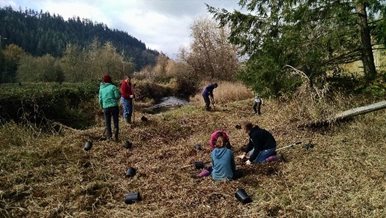State Department of Ecology Director Maia Bellon approved the Nisqually planning group’s updated plan for the watershed, spanning portions of Pierce, Thurston and Lewis counties.
The watershed plan identifies projects to offset the effects of new domestic wells on groundwater flow. This assures water for new rural homes, while helping keep water in streams for fish.
“I appreciate and applaud this impressive work by the Nisqually planning team,” said Bellon. “They collaborated under the pressures of an ambitious deadline, delivering solutions to accommodate rural growth and protect streamflows, so both people and fish can have the water they need.”
The Nisqually planning group is made up of tribal, local, and state governmental agencies, as well as a non-profit organization. Their plan is intended to accommodate residential growth forecast for the next 20 years.
“We are very excited to have met our obligations and produced a path forward through this contentious issue,” said David Troutt, Natural Resources Director for the Nisqually Indian Tribe, the planning group’s lead local agency. “This effort is the result of six months of commitment by all of us in the Nisqually, and is really a demonstration of the 30 years of developing trust and relationships in our watershed that allows us to collaboratively solve complex problems. We are confident that this effort will be good for our watershed community and our salmon.”
With Ecology’s approval of the updated watershed plan, local agencies can begin implementing projects that offset the impacts of residential wells on streamflows.
Examples of projects identified in the plan include:
- Connecting new and existing homes in Yelm’s Urban Growth Area to the city water system, and decommissioning existing wells.
- Transferring water rights in the Prairie area of Pierce County to the state’s water rights trust to benefit streamflows.
- Restoring wetlands in the Ohop Creek floodplain to better retain water for more steady release throughout the year.
- Storing water in underground aquifers for release to augment stream flows in the late summer and early fall.
The projects will help achieve the law’s requirement to provide net ecological benefits.
Ecology will receive annual progress reports and will evaluate the effectiveness of the Nisqually plan after five years.
The 2016 Supreme Court’s “Hirst” ruling changed how counties review and approve permit applications for homes and other buildings that would rely on well water. The new streamflow restoration law set up a planning process that requires local plans in 15 watersheds, statewide, to offset water consumption from new wells.
Watersheds have different schedules for developing a plan. If a local planning group cannot submit a plan by the deadline, Ecology will complete the law’s requirements for that watershed, using the state’s public rulemaking process.
The Nisqually and Nooksack watershed plans were due by Feb. 1, 2019. Despite hard work and commitment, the Nooksack watershed planning group did not approve a plan for Ecology to evaluate and adopt by the deadline. The law requires Ecology to complete rulemaking for the Nooksack by August 1, 2020.
“We commend the Nooksack participants’ hard work, collaboration and commitment,” Bellon said. “They made tremendous progress, but faced a challenging deadline. We look forward to building on their successful foundation as we move ahead.”


